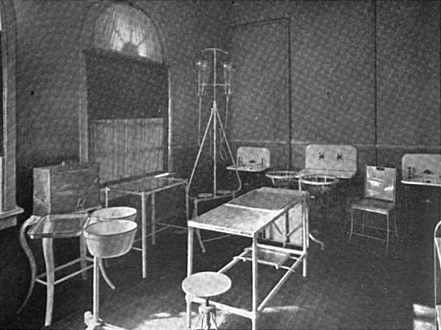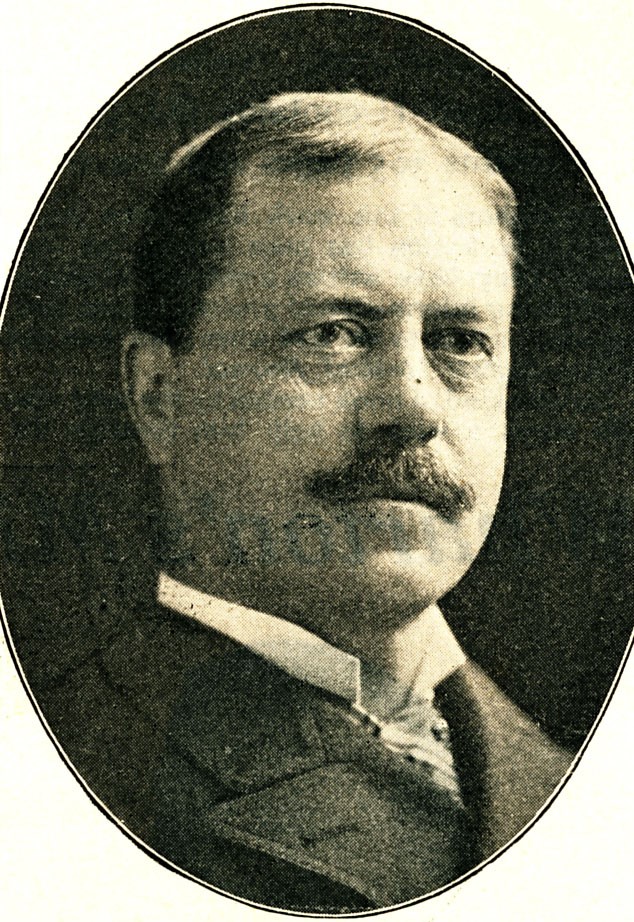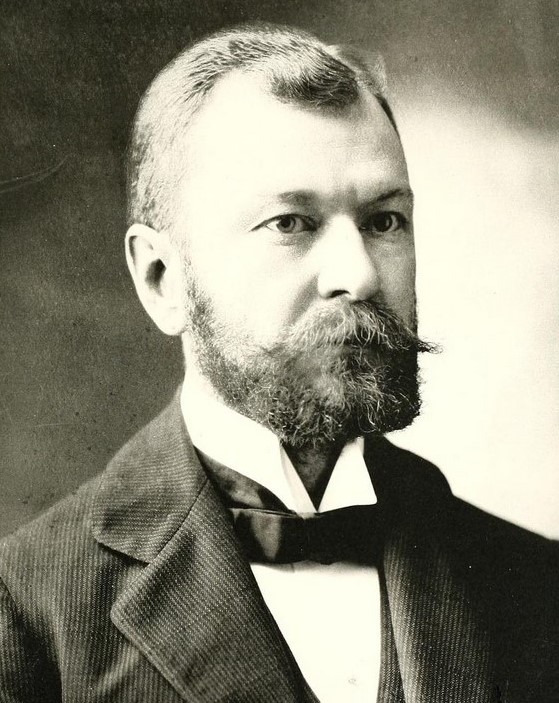The Assassination
By Emma Florio, Special Collections Library Assistant
On September 6, 1901, people lined up to shake the hand of President William McKinley at the Pan-American Exposition in Buffalo, New York. With dozens of police, exposition security guards, and US Army soldiers patrolling the area, members of the public approached McKinley one by one. Usually, people greeting the president had to do so with an empty, open hand. Because of the heat of the day, many people held handkerchiefs to wipe sweat from their faces and the rule was not enforced.
 |
|
The operating room at the Exposition hospital, from The Trained Nurse and Hospital Review, October 1901, via Wikipedia
|
Taking advantage of this laxity, Leon Czolgosz, a 28-year-old self-described anarchist, approached McKinley with a small revolver hidden under a handkerchief in his right hand. He shot McKinley twice in the abdomen at point blank range. The President was rushed to the Exposition’s hospital, which was equipped with a rudimentary operating room. No fully qualified doctor was on site; the Exposition’s medical director, Roswell Park, was away at the time. Other physicians who were attending the Exposition began to arrive, including Chicagoan Willis D. Storer. Even though the Exposition’s displays included a primitive x-ray machine, the physician put in charge, Matthew D. Mann, decided not to take x-rays before cutting into the president’s body, believing that it would only disturb his patient and not do any good. He attempted to find and remove the bullets but only found entry and exit wounds in McKinley’s stomach, which he stitched up. Roswell Park finally arrived as the procedure was nearing completion. Deciding not to place any drains, which would have helped remove pus and other fluids, Mann finished the operation and McKinley was moved to a nearby house to recover.
For nearly a week McKinley seemed to be getting better but by September 12 he developed abdominal pain and, unbeknownst to his doctors, gangrene had begun to grow on the walls of his stomach. McKinley died in the early hours of September 14. Later that day, McKinley’s vice president Theodore Roosevelt was sworn in as president. A subsequent autopsy revealed that a bullet had passed through McKinley’s stomach, then through his colon, also damaging his kidney, adrenal glands, and pancreas. Modern scholars generally believe he died of pancreatic necrosis (a sudden inflammation of the pancreas, in this case caused by trauma), which is difficult to treat even with modern medicine and would have been impossible to treat in 1901.
Northwestern Connections
Two Northwestern alumni were present in the operating room with McKinley: Roswell Park, an 1876 graduate of the medical school, and Willis D. Storer, an 1888 graduate. Each led full lives beyond their involvement in this important moment in history.
 |
|
Portrait of Park, Galter Library Special Collections.
|
After receiving his MD, Roswell Park (1852-1914) completed an internship at Cook County Hospital where he developed a skill for treating gunshot wounds. He then taught anatomy at the Woman’s Medical College of Chicago and Chicago Medical College (the precursor to the Feinberg School of Medicine) for 5 years before becoming Professor of Surgery at the University of Buffalo, a position he held for 31 years. He played a major role in the application of Joseph Lister’s antiseptic techniques to American surgery, both through his writing and through his practice as a surgeon. He is best known today for founding the Gratwick Laboratory in 1898, which eventually became the Roswell Park Comprehensive Cancer Center, the first such center in the US, combining research, education, and treatment in one facility.
Due to his prominence in Buffalo, Park was appointed the Medical Director of the 1901 Pan-American Exposition. On the day McKinley was shot, Park was 20 miles away in Niagara Falls performing a delicate neck operation. A train was sent to bring him back to Buffalo, which on its return trip broke the record for the fastest time traveled between the two cities. Unfortunately, Park arrived as the operation to find the bullets in McKinley’s abdomen was nearly complete. Given his expertise in the treatment of gunshot wounds, many people speculated that the outcome may have been different if he had been there from the beginning.
 |
|
Portrait of Storer, from Prominent physicians...of Cook County, via Archive.org
|
Willis D. Storer (1862-1935) spent 40 years as a physician in Chicago, including as an attending physician at Maurice Porter Hospital, the precursor to Lurie Children’s Hospital. He moved to Los Angeles in 1930 and continued his medical practice, which included many Hollywood actors and actresses.1
Storer attended the Pan-American Exposition as the guest of Dr. M. Coney, who oversaw the Paris Incubator Hospital exhibit at the fair. Although accounts differ, it is clear that Storer ended up in the Exposition Hospital on September 6, whether he had already happened to be there, or he heard about the shooting of the President and rushed over. In an article for the Chicago Daily Tribune, he remarked that all the physicians present agreed that McKinley needed to be operated on and that the usual antiseptic precautions were taken.
More Presidential Connections
Eleven years after McKinley’s assassination, another physician with a Northwestern connection would be involved in the treatment of a wounded president, with many parallels to the McKinley assassination. In October 1912, J. B. Murphy, Professor of Surgery at the medical school, tended to Theodore Roosevelt at Chicago’s Mercy Hospital after he had been shot in Milwaukee while campaigning for an unprecedented third term as president. Roosevelt’s would-be assassin would later explain that William McKinley had appeared to him in a dream and told him to avenge his death by killing Roosevelt. Roosevelt’s life was potentially saved by the use of x-ray scans, which had not been done for McKinley. The scans showed the location of the bullet and helped Murphy to determine that it was safer to leave it in place.
Read more about this event on our website and visit our display about Murphy and the attempted assassination of Roosevelt in the Eisenberg Gallery connecting the Ward Building and the Method Atrium.
Endnotes
1. Storer had tended to Hollywood stars earlier in his career as well. While in Los Angeles in 1895 he delivered Berkeley William Enos, who would become known as the film director and musical choreographer Busby Berkeley, and in 1899 he delivered future film star Gloria Swanson in Chicago.
Selected References
Cancer Research & News. “Who was Dr. Roswell Park?” Roswell Park Comprehensive Research Center, April 19, 2021.
Miller, Scott. The President and the Assassin: McKinley, Terror, and Empire at the Dawn of the American Century. New York: Random House, 2011.
“Time Factor in M’Kinley’s Case: Dr. Storer, Who Assisted in Operation, Returns and Describes Surgery.” Chicago Daily Tribune, September 10, 1901.
Updated: September 6, 2023